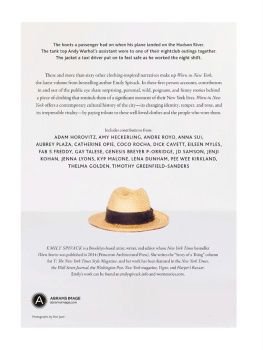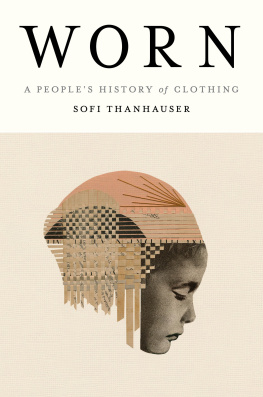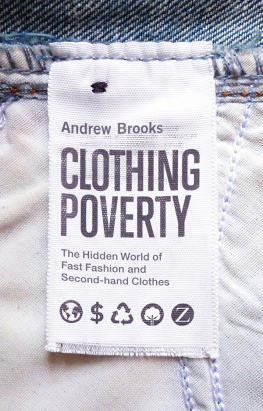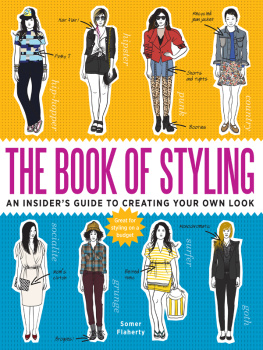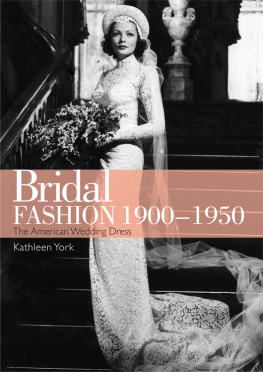
Published by
Princeton Architectural Press
37 East Seventh Street
New York, New York 10003
Visit our website at www.papress.com
Visit Worn Stories at www.wornstories.com
2014 Princeton Architectural Press
All rights reserved
ISBN: 978-1-61689-276-0 (hc)
ISBN: 978-1-6168-9360-6 (ebook)
No part of this book may be used or reproduced in any manner without written
permission from the publisher, except in the context of reviews.
Every reasonable attempt has been made to identify owners of copyright.
Errors or omissions will be corrected in subsequent editions.
The Louise Bourgeois text on was reprinted with permission from
Louise Bourgeois, The Return of the Repressed, Volume II: Psychoanalytic Writings
(London: Violette Editions, 2012), 144.
Louise Bourgeois, c. 1968. Loose sheet: 11 8 in. (27.9 21.6 cm); LB-0202.
The Easton Foundation.
The photograph on : Marina Abramovi on the Great Wall of China, 1988.
Courtesy of the Marina Abramovi Archives.
A version of Davy Rothbarts story appears in his collection of personal essays,
My Heart is an Idiot (New York: Farrar, Straus, and Giroux, 2012).
Editor: Meredith Baber
Designer: Paul Wagner
Photography: Ally Lindsay
Special thanks to: Sara Bader, Nicola Bednarek Brower, Janet Behning, Megan Carey,
Carina Cha, Andrea Chlad, Barbara Darko, Benjamin English, Russell Fernandez,
Will Foster, Jan Haux, Diane Levinson, Jennifer Lippert, Katharine Myers, Jaime Nelson,
Jay Sacher, Rob Shaeffer, Sara Stemen, Marielle Suba, and Joseph Weston
of Princeton Architectural Press Kevin C. Lippert, publisher
Library of Congress Cataloging-in-Publication Data is available from
the publisher upon request.
it gives me a great pleasure to keep my clo thes my dresses, my stockings, I have never thrown away a pair of shoes of mine in 20 years. I cannot separate myself from my clothes nor Alains The pretext is that they are still good it is my past and as rotten as it was I would like to take it and hold it tight in my arms
LOUISE BOURGEOIS , 1968
INTRODUCTION
On a brisk winter day in late 2013, I took my students on a tour of a national thrift-store chains largest distribution center in Brooklyn as part of an undergraduate course I was teaching. The four-story buildinga converted horse stable built in the early 1800swas humming with activity. We were shown each floors dedicated purpose in sifting through the tons of clothing, as well as bric-a-brac, electronics, and furniture, that arrive each day. Jeans, T-shirts, skirts, unworn designer wedding dresses, shoes, winter coats, and bathing suits were emptied by the truckload each morning on the first floor. Then they were sorted, priced, and hung on plastic hangers on the third floor, brought to the store on the second floor, put into out-of-season storage on the fourth floor, or taken back down to the first floor, where they were reloaded onto a truck and taken to another one of the thrift stores many locations throughout Brooklyn.
The sheer quantity of clothing passing through this facilityabout ten thousand pieces per daywas astounding. Even more eye-opening was what happened to the clothes that werent deemed worthy by the stores sorters. They were dumped down a chute, called the hole. The mounds of clothes landed in a bin on the first floor and piled up until a machine compressed them into thousand-pound cubes. Those packages were then sold in bulk to distributors who shipped them to third-world countries or shredded them into rags.
The clothes were no longer recognizable for their function or style after they had been packed into cubes. It was hard to believe that someone had once worn them. You know when you repeat a word over and over, and suddenly the word becomes unfamiliar, strange-sounding? It was like that, but with clothes. They became meaningless stuff. Each garment had lost all attachment to its previous owner and its intended use. It had nothing to do with fashion. And there was just so much of it.
Who had worn the garment before it was donated to the thrift store? Where had it been? What was the previous owner like? Except for a lingering scent of perfume or body odor, a stain, or a movie stub in the pocket of a pair of jeans, that history, and each garments provenance, was lost.
These are questions I was asking when I started the Worn Stories project in 2010. I was curious about our garments histories and wanted to create a place to record and preserve these stories: first, my own; then, entries from my friends and family; and, eventually, the stories of strangers.
Our clothes are full of memory and meaning. Thats why we all have garmentshanging in our closets, shoved in the backs of drawers, and boxed up in garagesthat we havent worn in years but just cant part with. And then there are the clothes we wear every day, whose stories are still unfolding.
My own closet is full of clothes; it is also an evolving archive of experiences, adventures, and memories. I began using my clothes to write about those experiencesmy first concert T-shirt, a hand-me-down scarf, a handmade sweater. Quickly, three things became clear: First, clothes can be a rich and universal storytelling device. Second, I was much more interested in the clothing-inspired narratives of other people than in my own. And third, if those stories arent captured, they disappear.
For the Worn Stories website, wornstories.com, and eventually for this book, I asked for stories from people I knew or admiredartists, musicians, writers, filmmakers, chefs, entrepreneurs, and designers. I put out a call to friends and acquaintances Id known for years. And I solicited contributions on the Worn Stories website, from listservs, and via Craigslist. Most contributors told me their stories; others wrote them themselves. In each case, the request was the same: Select a piece of clothing still in your possession with a compelling story behind it, whether something spectacular, unexpected, weird, wonderful, or momentous happened while you were wearing it. And share what you remember. As a result, the subject matter of these tales ranges from the everyday to the extraordinary. They include recollections about clothing worn during a breakup and during a kidnapping, while accidentally tripping on acid and while taking aerobics classes, on a visit to the White House and on a trek along the Great Wall of China.
The intent of this book is simple: that these tales will not only offer a glimpse into the lives of these contributors but also prompt you, the reader, to reconsider the role of clothing in your own lifebefore your clothes someday wind up in anonymous piles like those I saw at the thrift stores distribution facility.
The clothes that protect us, that make us laugh, that serve as a uniform, that help us assert our identity or aspirations, that we wear to remember someonein all of these are encoded the stories of our lives. We all have a memoir in miniature living in a garment weve worn. This book brings some of those stories to light.
EMILY SPIVACK

Andy Spade
My job is to give this jacket a second life. The woman who sold it to me at a flea market on 25th Street told me it had been sitting in her attic for fifteen years, since her husband died. When I got it, it was barely wearable because it was so stiff, and it was covered in dust. Anytime I would wear it, Id come home and my wife, Kate, would say, Your shirt and pants have green dust on them. It bleeds whenever I wear it. Im not being a weirdo, but I feel like I have a part of this person on me, like Im actually borrowing his character.
Next page

